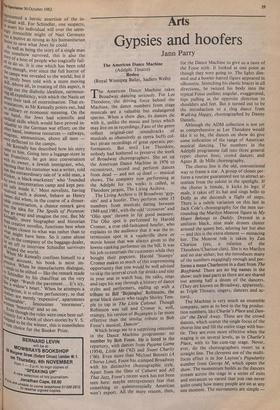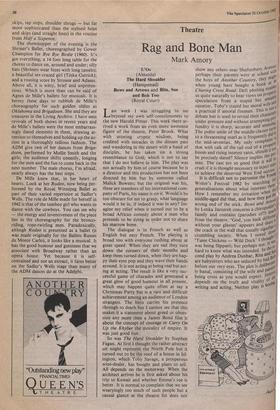A rts
Gypsies and hoofers
Jann Parry
The American Dance Machine takes Broadway dancing seriously. For Lee Theodore, the driving force behind the Machine, the dance numbers from stage musicals are a valuable but endangered species. When a show dies, its dances dic with it, unlike the music and lyrics which may live on in recordings. Fans of the genre collect original-cast soundtracks of musicals as obsessively as opera buffs col- lect pirate recordings of great operatic per- formances. But until Lee Theodore, nobody had bothered to preserve the work of Broadway choreographers. She set up the American Dance Machine in 1976 to reconstruct, record and perform dances from dead — and not so dead — musical shows. The company now performing at the Adelphi for six weeks is called, in Theodore jargon, The Living Archive. The Living Archive is 19 Broadway 'gyp- sies' and a hoofer. They perform some 15 numbers from musicals dating between 1949 and 1981, with the odd 'crossover' and `Olio spot' thrown in for good measure. The Olio spot is performed by Harold Cromer, a true old-fashioned hoofer, who explains to the audience that it was the in- termission spot in a vaudeville show or movie house that was always given to the lowest-ranking performer on the bill. It was his job to entertain the customers while they bought their popcorn. Harold 'Stumpy' Cromer makes so much of this unpromising opportunity that you would be well advised to skip the interval crush for drinks and stay in your seat to watch* him. He talks, sings and taps his way through -a history of dance styles and performers, ending up with a tribute to Bill `Bojangles' Robinson, the great black dancer who taught Shirley Tem- ple to tap in The Little Colonel. Though Robinson was tall and Cromer is, well, stumpy, his version of Bojangles is far more effective than the similar tribute in Bob Fosse's musical, Dancin'. Which brings me to a surprising omission in the Dance Machine programme: no number by Bob Fosse. He is listed in the repertory, with dances from Pajama Game (1954), Little Me ('62) and Sweet Charity ('66). Even more than Michael Bennett (A Chorus Line), Fosse has stamped Broadway with his distinctive choreographic style. Apart from the films of Cabaret and All That Jazz, Fosse's recent work has not been seen here: maybe entrepreneurs fear that something so quintessentially American won't export. All the more reason, then, for the Dance Machine to give us a taste of the Fosse style. It looked at one point as though they were going to. The lights dim- med and a bowler-hatted figure appeared in silhouette. Stretching his elastic braces in all directions, he twisted his body into the typical Fosse outline; angular, exaggerated, hips pulling in the opposite direction to shoulders and feet. But it turned out to be the introduction to a clog dance from Walking Happy, choreographed by Danny Daniels.
Although the ADM collection is not yet as comprehensive as Lee Theodore would like it to be, the dances on show do give some indication of the range of American musical dancing. The numbers in the Adelphi programme fall into three general types: chorus lines; crowd dances; and Agnes B. de Mille choreography.
The chorus _line is the old, conventional way to frame a star. A group of clones per- form a routine guaranteed not to attract at- tention from the soloist in the spotlight. If the chorus is female, it kicks its legs; if male, it takes off its hat and sings hello to Dolly as she descends a flight of steps. There is a subtle variation on this last in Jack Cole's choreography for the men sur- rounding the Marilyn Monroe figure in My Heart Belongs to Daddy. Dressed in a uniform black, nine male drones cluster around the queen bee, adoring her but also — and this is the extra element — menacing her. The Monroe role is taken by Zan Charisse (yes, a relation of the Theodore/Charisse clan). She is no Marilyn and no star either; but she introduces many of the numbers engagingly enough and per- forms a mean Charleston in a duet from The Boyfriend. There are no big names in the show: such lead parts as there are are shared out among half a dozen of the dancers. (They are known on Broadway, apparently, as Triple Threats; singers, dancers and ac- tors). The Machine is very much an ensemble company, seen at its best in the big produc- tion numbers, like Charlie's Place and Dan- cin' the Devil Away. These are the crowd dances, which scatter the single focus of the chorus line and fill the entire stage with bus- tle. They are even more effective when the staging is on several levels, as in Charlie's Place, with its bar-cum-tap stage. Never, ever, do the choreographers resort to a straight line. The cleverest use of the multi- focus effect is in Joe Layton's Popularity number from George M, which opens the show. The momentum builds as the dancers stream across the stage in a series of exits and entrances so varied that you can never quite count how many people are on at any one moment. The movements are simple —
skips, tap steps, shoulder shrugs — but far more sophisticated than the stylised hops and skips (and straight lines) in the routine from Half a Sixpence.
The showstopper of the evening is the Shriner's Ballet, choreographed by Gower Champion for Bye Bye Birdie (1960). It's got everything; a 14 foot long table for the chorus to dance on, around and under; silly hats (Shriners wear fezes with long tassels); a beautiful sex-crazed girl (Tinka Gutrick); and a rousing score by Strouse and Adams. Above all, it is witty, brief and unpreten- tious. Which is more than can be said of Agnes de Mille's ballets for musicals. It is heresy these days to rubbish de Mille's choreography for such golden oldies as Oklahoma and Brigadoon. She and they are treasures in the Living Archive. I have seen revivals of both shows in recent years and de Mile's ballets were the most embarrass- ingly dated elements in them, drawing at- tention to themselves and holding up the ac- tion in a thoroughly tedious fashion. The ADM give two of her dances from Briga- doon, performed by Mollie Smith and the girls; the audience shifts uneasily, longing for the men and the fun to come back in the next number. The male chorus, I'm afraid, nearly always has the best steps.
De Mille knew that, in her heart of hearts. Look at her Rodeo, now being per- formed by the Royal Winnipeg Ballet as part of their varied repertoire at Sadler's Wells. The role de Mille made for herself in 1942 is that of the tomboy girl who wants to dance with the cowboys. You can see why — the energy and inventiveness of the piece lies in the choreography for the bronco- riding, rope-twirling men. Paradoxically, althogh Rodeo is presented as a ballet (it was made originally for the Ballets Russes de Monte Carlo), it looks like a musical. It has the good humour and gutsiness that we associate with Broadway rather than an opera house. Yet because it is self- contained and not an extract, it fares better on the Sadler's Wells stage than many of the ADM dances do at the Ade1phi.











































 Previous page
Previous page